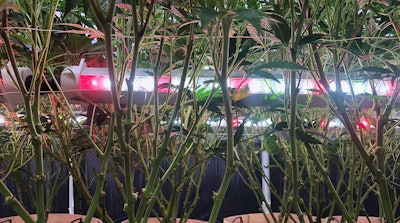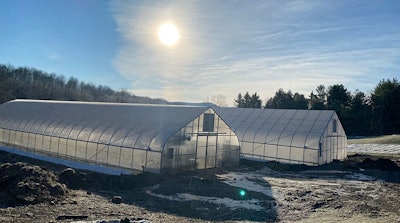
Mike and Jennifer Palulis were in their eighth season running Echo Creek Farm, growing purple kale, spinach, arugula, garlic, strawberries, tomatoes and more for New York City and local farmers markets, when someone approached them with a business opportunity in cannabis.
New York state had legalized adult-use cannabis the year before—the offer came in 2022—but Palulis says the industry really wasn’t on his radar at all. The family’s vegetable farm business, cultivated on rocky but fertile terrain in upstate New York near the Vermont border, was thriving.
“We were in the peak of our vegetables. Everything was doing good. We were building really nice infrastructure with cashflow and solar systems and updating greenhouses,” Mike Palulis says of the farm, which includes 2.5 acres of field-grown vegetables and 14,000 square feet between six greenhouses.
But their three children were getting older. He drove to New York City twice a week to sell his wares at markets in Chelsea and just north of Central Park in Harlem, including Saturdays, a 21-hour day when considering the drive there and back. A former restaurant owner, Palulis had sold his business to launch the farm partly so he could spend more time with his family. Now, he found himself in a similar situation, losing precious weekends with his kids.
Palulis didn’t have a license to cultivate cannabis, but he had the land, growing experience, and infrastructure. When the owner of Misty Bleu Farm, which was among the group of hemp farms awarded the initial adult-use cannabis cultivation licenses in the state, approached him, asking if he’d be interested in a contract grow for cannabis cultivation, he thought, why not?


“We weren't trying to be like, let's make a million dollars on this. If we could break even with the city [farmer’s markets], if it did a little bit better, all the better,” Palulis says. “So we agreed to it and that was the foothold into the cannabis industry.”
The first season, Palulis grew Misty Bleu's crop under three tunnels, each totaling 3,000 square feet.
“We pulled off a main season grow in year one, and then we converted the tunnels to light deprivation. We were hoping for year two to be the big explosion of New York state, which didn’t quite happen,” Palulis says.
Then, more offers started coming.
“Literally none of these guys had any infrastructure. Their dream the first year was, you won the lottery [license], now you're going to grow a good outdoor crop. And then they were going to build this infrastructure the next year,” Palulis says. “But unfortunately, it was a rough rollout in New York, so a lot of that didn't happen for people.”
After legalizing adult-use cannabis through legislative action, it took officials nearly two years to open the first regulated dispensary in the state. The plan was to give local growers, hemp farmers who had struggled with declining prices for their crop, a head start growing for the new market. But the retail rollout was much slower than anticipated, and unregulated stores took hold, leaving growers with supply they couldn’t sell, and less revenue to fund infrastructure projects and fuel business growth.
“Everyone slowed down a little bit. The market avenue wasn't quite open. Eventually we started the plants for a lot of firms the first year and were contract growing for people,” Palulis says. “But that led to a number of firms just coming to the property interested in infrastructure because they still didn't have a greenhouse second year.”
By the second year, Palulis and his wife had created a cannabis cultivation hub for about four brands. They were cultivating cannabis plants for two licensees, renting one of their greenhouses out to another, while yet another entrepreneur was building a greenhouse on their property. They now operate four greenhouses and 9,000 square feet dedicated to cannabis.
“The idea was, we'll buy it back at depreciated value over time, depending on how long they were going to hang out on the property,” says Palulis, who is now pursuing his own license.
As many licensed growers will note, the first year was taxing, as farmers were growing cannabis for a retail network that was not yet established, Palulis says.
“I was in the same boat as the license holders, and it was stressful. I think I haven't met one farm that wasn't stressed by year one,” he says. “We had given up our most valuable vegetable real estate to grow cannabis, and with a slow rollout, the licensees struggled with the timing of the payments, which had set us back quite a bit.
“We were on the verge of just sinking the whole vegetable farm and everything, and we didn't even have a license.”
That second year, as regulated stores started opening, many licensees were primarily growing cannabis outdoors, and farmers were hit with terrible weather.
“New York had one of the wettest seasons. It’s not an outdoor crop for flower. You just hope for the best weather, but it’s meant to be a greenhouse mixed light or an indoor industry,”
Palulis says.
As fate would have it, one of the companies growing on the Palulis property, Outcast Acres had just started experimenting with a 16-light covered operation with light deprivation. The owner was eventually planning on expanding the supplementing light to the full 3,000-square-foot greenhouse, but Palulis and the owner wanted to learn on a smaller scale first.

“And the quality of flower was just so amazingly different from anything that we had done. And it was the same genetics and yield—I mean yield is double with lights compared to dependent on the sun,” Palulis said. “That was the middle of last year, when people were having a problem finding flower. The industry started to pick up a little bit, but then there was a lot of moldy weed out there. But we had the small greenhouse coming in, and it was just a 30-pound harvest.”
Having seen how powerful supplemental light could be in a greenhouse, the grower Palulis had been working with reached out to Fluence, the global leader in cannabis LED lighting with over a decade of experience. With an eye toward eventual expansion, the grower wanted to find lighting that was less labor intensive and didn’t need to be on retractable ropes or require bulb changes between veg and flower. Fluence LEDs we the perfect solution. Another goal of the trials was to compare traditional overhead lighting with intercanopy lighting to see if yield and quality could improve when the lights were reaching more of the plant. Palulis wanted to see how the VYNE intercanopy lights from Fluence would perform.
Echo Creek set up two five-foot-wide beds, approximately 90 feet long, one on each side of the greenhouse. Both beds were equipped with Fluence 630W VYPR BW4 top light fixtures and received a total supplemental lighting flux density of 900 µmol·m-2·s-1. For the intercanopy trial bed, two rows of Fluence VYNE R6 intercanopy fixtures were installed and the top light fixture count reduced such that approximately 200 µmol·m-2·s-1 (22%) of the total flux was shifted into the canopy. The wattage in the intercanopy bed was 13% lower than the top light bed while producing the same amount of light.
So far, Echo Creek has grown two rounds with legacy lights and three with the new Fluence lights, and has been impressed with the dramatic changes.
“The yield was up, it was a little bit cooler in the summer heat for BTU, so I really loved it. I turned that greenhouse five times in the last year and improved on it each time,” Palulis said. “I was excited to be part of the trial. These lights here will go to the grower that's under the license, but I'll be looking to replace these lights with Fluence. They've been great to work with. We increased yields quite a bit and then just the ease of working in general with the lights has been great.”
Since using LEDs in that trial alone, Palulis has been able to increase yields from around 20 pounds to 40 of trimmed flower. Most likely, he’ll explore intercanopy lighting because not only have yields gone up, but the bud grade of the lower canopy has improved dramatically.
Palulis was apprehensive that the VYNE lights would be labor intensive, but they found after the trial that this was not the case.
“We designed our own system here to hang the lights. We top dress for organic soil grown growers, and I was like, ‘Oh, these are going to be in the way for top dressing when you're hanging trellis in. Is it going to be worth the extra labor and the burden? But they hang off the bottom. We're able to top dress and prune, no problem. We have a pretty nice system for connecting it through the trellis,” he said. “It seems like [intercanopy] pushed the yield and grade, so it seems pretty promising right now.”
